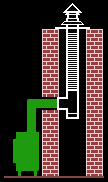I'm obviously missing something. ;-) In all my reading about DIY stainless chimney liners, I can't figure out how the cleanout works.
In particular, if you have a chimney setup like in this diagram, how does one remove creosote after cleaning the chimney? Do you have to remove the stove pipe where it enters the chimney inside the house, to access the bottom of the T?
Our old brick chimney is similar to that diagram, but it continues downward to an unfinished basement below, where the current cleanout hole is. It seems sad to waste all of that chimney height for a liner that only extends to the stove opening, but I know it needs to be relined. So I'm doing my research.
The good news is I think we really could do this ourselves, since the chimney is straight, the length of liner would be less than 15 feet, and the roof is easy to work on.
Thanks in advance for any clarification,
- Rachel
In particular, if you have a chimney setup like in this diagram, how does one remove creosote after cleaning the chimney? Do you have to remove the stove pipe where it enters the chimney inside the house, to access the bottom of the T?
Our old brick chimney is similar to that diagram, but it continues downward to an unfinished basement below, where the current cleanout hole is. It seems sad to waste all of that chimney height for a liner that only extends to the stove opening, but I know it needs to be relined. So I'm doing my research.
The good news is I think we really could do this ourselves, since the chimney is straight, the length of liner would be less than 15 feet, and the roof is easy to work on.
Thanks in advance for any clarification,
- Rachel



